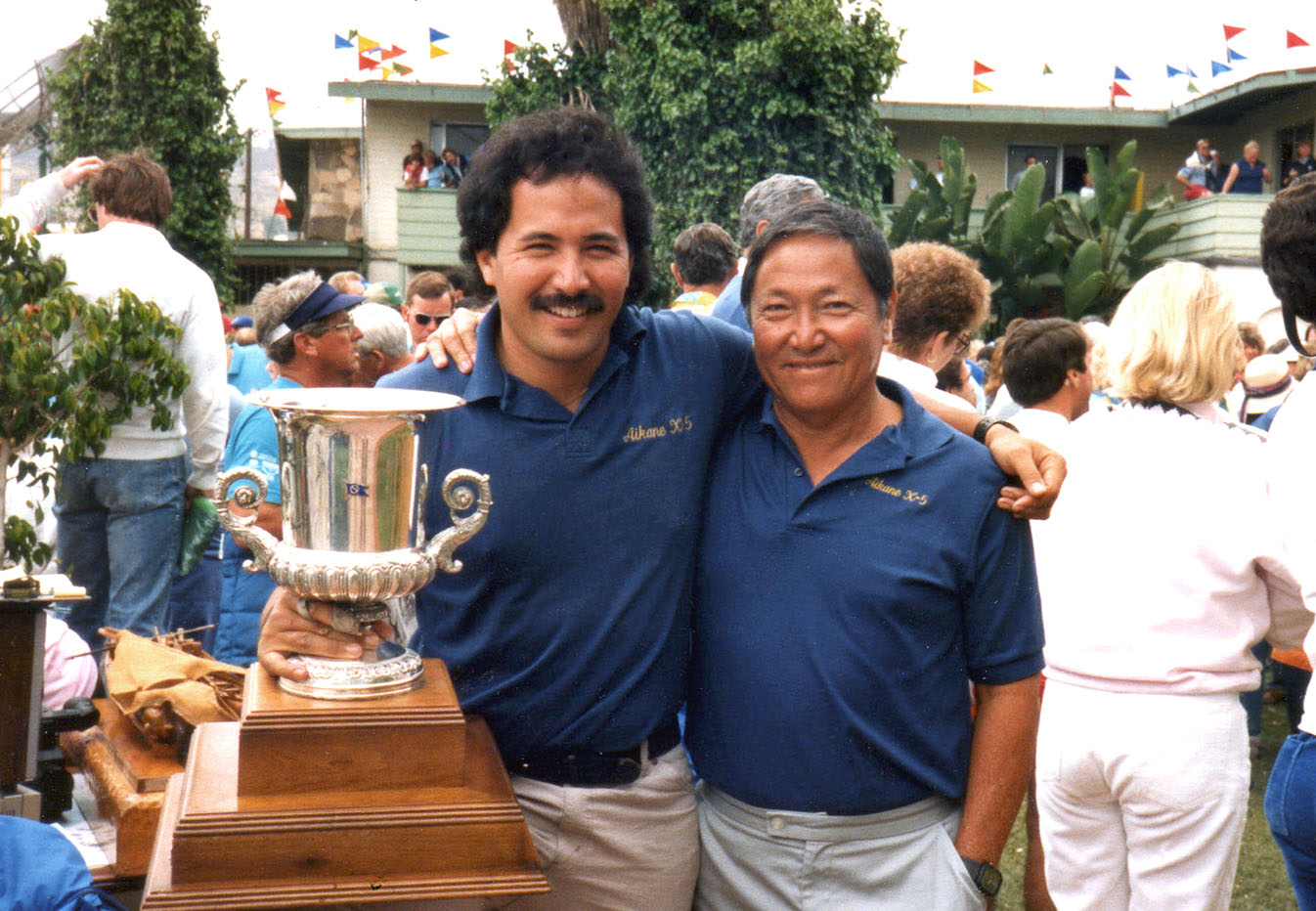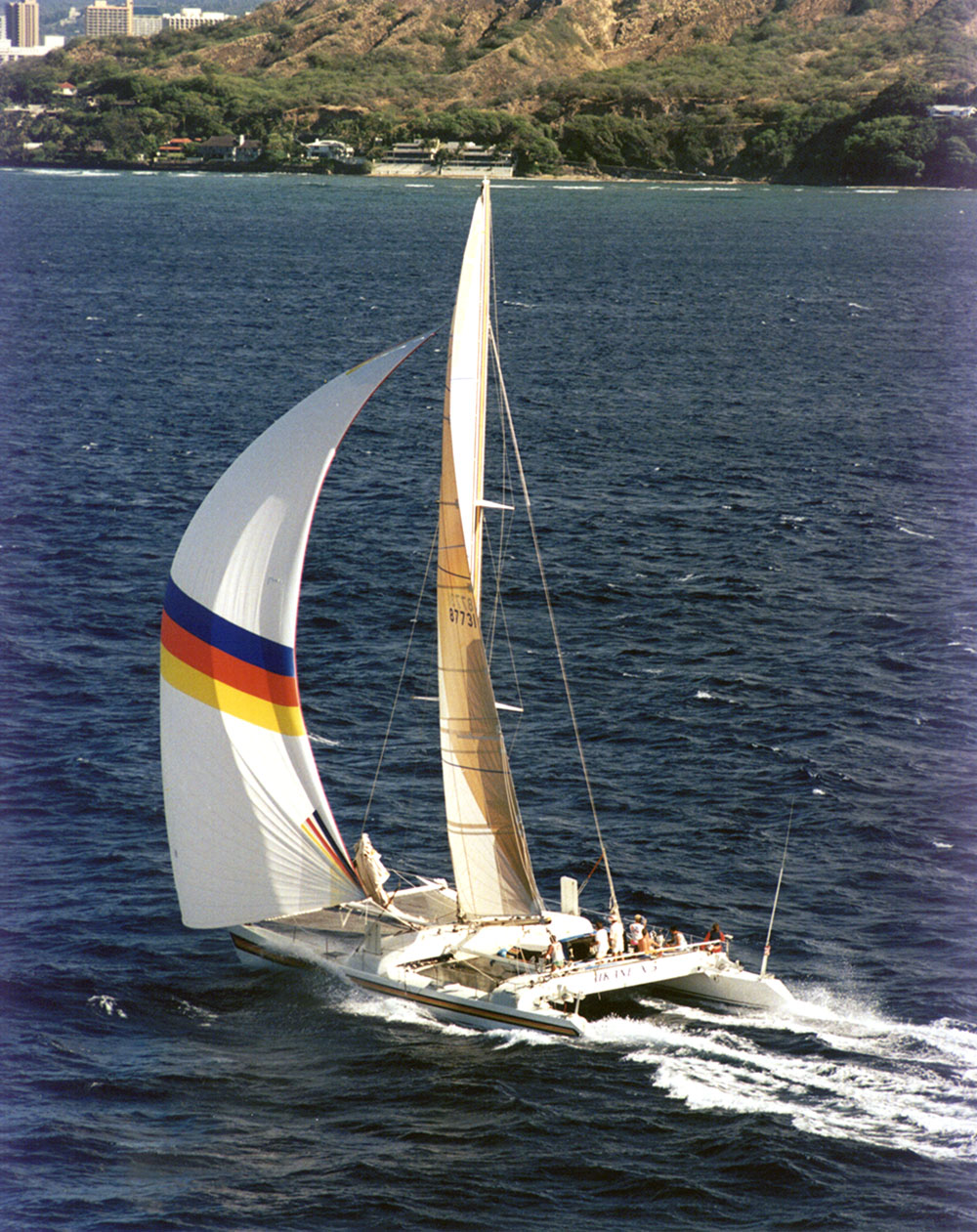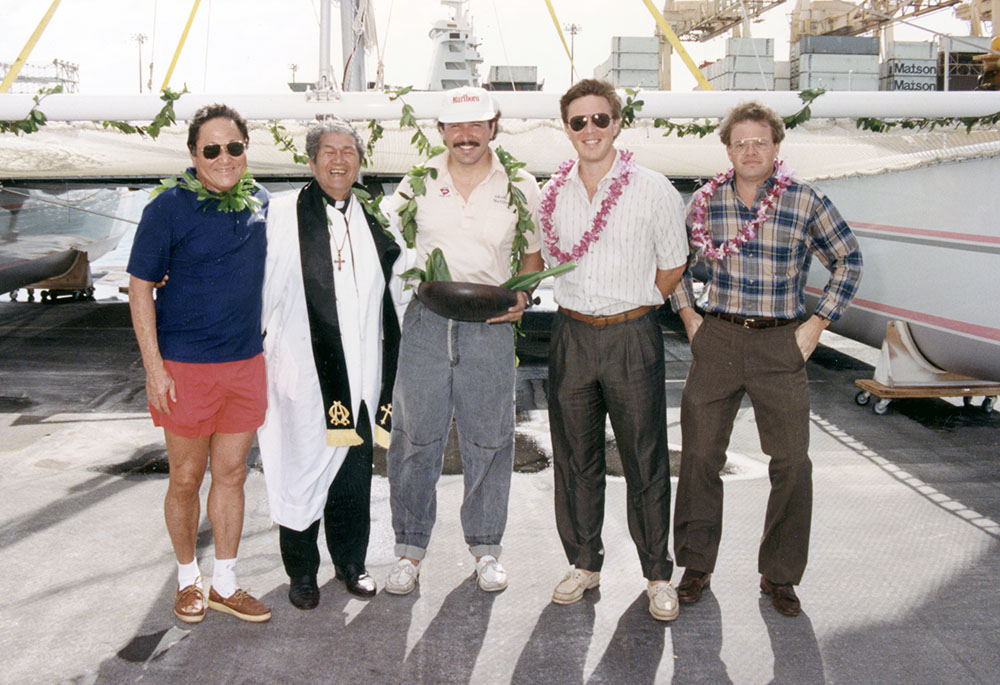By Barry Choy
Alfred Kumalae, Rudy’s childhood friend, was responsible for teaching him about the sea. Rudy’s father was a businessman and immigrant from Korea with little understanding of the ocean. It was Alfred who first taught Rudy to study the wake of their surfboard (tied to the bank in a river near Hilo on the Big Island of Hawaii) as they fished, in order to begin to understand how surfaces behaved in the water. He also taught Rudy how to paddle a canoe and how to sail.
With Alfred and Woody Brown, a famed international glider pilot and aerodynamicist, Rudy helped create the very first modern catamaran, Manukai, in 1947. When Rudy decided to leave Hawai’i for better economic opportunities in the post-war mainland of 1950, Alfred was al-ready living in Los Angeles. Rudy had his first experience crewing in the Newport Beach to Ensenada, Mexico Race (not in a catamaran!) and shortly thereafter, met Warren Seaman. Following Rudy’s first solo design effort, the 44′ Aikane, he formed C/S/K Catamarans with Warren and Alfred. Sometime in the early 60’s Vince Bartolone, who had done much of the drafting during that time, joined the partnership. Vince and his superb eye for style, helped define the famous look that all C/S/K designs have.
The successes (with a few tribulations) are told in “Catamarans Offshore,” The MacMillan Company, 1970. Unfortunately, it is out of print. Alfred left the partnership sometime in the late 1960’s and has since passed away, but Rudy, Warren and Vince continued to work together periodically until 1989 or so, roughly the time that Aikane X5 set the TransPacific record.
As with so many other successful partnerships, each member contributed unique qualifications and talents to the whole. Here are my impressions of what those were.
Rudy Choy – He was the driving force, one of the most determined and persistent people I’ve ever known. Although initially Alfred’s pupil, he took his knowledge to another level by applying one of his mentor’s greatest lessons: empiricism, or understanding through careful observation. In addition to having a natural grasp for proportion he is one of the greatest natural helmsmen I’ve ever seen. Because he was no mere “armchair” designer and always conducted maiden voyages himself, he had great credibility with the clients. Rudy was also well-read and extremely eloquent, and as some have said, capable of selling ice to Eskimos. His name is most associated with the accomplishments of C/S/K though the others were instrumental to its successes.
Warren Seaman – I will forever see, in my mind, the image of Warren in the 1987 Newport Beach to Ensenada Race on Aikane X5 when we were First-to-Finish, First-Multihull, and First-Multihull Corrected time. At 9 in the evening in the Bahia de Todos Santos in winds so light that scraps of toilet paper attached to rigging hung slack, Warren, steering on the windward side, kept our 3,800 ft 2 Kevlar Randy Smyth spinnaker full and drawing while regaling us endlessly with sea stories dating back to the dawn of sail! Warren was simply intuitive and natural at everything he did. As a foil to Rudy’s “Gung-Ho” enthusiasm and flights-of-fancy, Warren – who is originally from New Jersey, and can still affect the accent – acted as a moderator and perhaps more than anyone else, ensured the excellent record of safety and longevity held by C/S/K boats; he was the great pragmatist. When C/S/K acted as builder, in addition to designer, it was Warren and Alfred who did the lion’s share of critical tasks, such as lofting, and detail work. Warren helped define the scantlings of every single one of C/S/K’s one hundred-or-so wood/fiberglass designs, and always possessed a natural feel for structure. Though retired, he still lives in Topanga Canyon, and sails to nearby Catalina Island as often as he can.
Alfred Kumalae – Like many ethnic Hawai’ians, Alfred was totally in-tune with nature and is most responsible for introducing Rudy to the sea. Though quiet and unassuming, Alfred was quite brilliant – a naturally gifted engineer and capable of doing amazing things with wood. I marveled at his woodworking skills while watching some of the detail and finish work on Seasmoke and others. He might best be described as the ‘deep-thinker’ of C/S/K but was also highly secretive and would even hide some of his notes from Warren. Alfred opted to leave C/S/K in the late 1960’s and has since passed away. Although he had lived in Los Angeles for most of his adult life, Alfred returned to Hilo, his hometown, just prior to his death.
Vince Bartolone – When people speak of the unique C/S/K styling, the person most responsible for that look is Vince. A gifted natural artist, Vince was a former air-craft mechanic in the military, and like Warren and Alfred, had a very technical, detailed approach to every project, capable of rendering thoughts and cocktail napkin sketches to finish plans faster than anyone I’ve ever seen. His concept artwork was responsible for landing many of the C/S/K’s projects and he created those signature color scheme’s, most notably, those of Machete (Vince actually painted her himself) and Aikane X5. Vince also handled most of the selection and specification of hardware and machinery. Although C/S/K ended as a business in the 1970’s, Vince continued on with Warren and Rudy as a co-designer and draftsman until 1989. From the earlier period to the present, Vince has continued with his firm Design Concepts, and his creations still possess that un-mistakable signature look, having graced the pages of MULTIHULLS on numerous occasions.
If you look collectively at the body of their work, Rudy and his partners left some rather evident clues to their most fundamental beliefs about multihull designs. Above all, they insisted on seaworthiness, the notion that every one of their designs could (and most did) cross an ocean. Simplicity and the avoidance of unnecessary complexity in design, whether talking about spars and rigging, machinery, hardware or amenities. Perhaps one of the most important convictions, and one of their greatest contributions, in my opinion, is the idea that weight is always crucial and the idea that even cruising or commercial vessels have weight limits for given sizes and applications that should not be exceeded lest the prime directive of seaworthiness be violated. Lastly, they believed in the finest tradition of Herreshoff and Stephens, that yachts must be beautiful.







